Shale Oil Splutters: Brent on Track for $70 Target $100 in 2020
Commodities / Crude Oil Mar 15, 2019 - 04:14 PM GMTBy: Andrew_Butter
 There is a sense of triumphalism in the tag-line, “U.S.A. is now a net oil exporter”. Reminiscent of “Mission Accomplished”; first it’s not true, second; what’s hiding in the wings is sinister.
There is a sense of triumphalism in the tag-line, “U.S.A. is now a net oil exporter”. Reminiscent of “Mission Accomplished”; first it’s not true, second; what’s hiding in the wings is sinister.- In February, in the Permian, Initial Production net Legacy-Loss (IPnL), which measures change in production capacity, was down 42% on the peak in May 2018
- 98.5% of changes in IPnL can be explained by changes in trailing average oil price. That sounds blindingly obvious; but there’s a catch.
- Shale oil output-growth affects oil prices; so there’s negative feedback-loop. What happened was legacy-loss in shale caught up, shale is still a “swing producer”; but soon they will need $70 WTI.
- Ten years ago the Saudi’s said $70-to-$80 Brent was “fair”, that’s what the world could afford, and what producers needed to bring in new oil, they said. They may get that, and more, soon.
Someone who was there told someone I know; that the day-before Deepwater Horizon blew, the HSE fascists had a party; no booze, no smoking, no trans-fats, no lap-dancers, lots of sugar; quite a party. It was to celebrate what a great job they had all done. Near-miss incident-reports on not holding handrails going down stairs; had halved, and the numbers of injuries from actually falling down stairs was 25% of two years before. It’s one thing to write and document a fifty-page risk-analysis, it’s another thing to get the big things right. Not many corporate risk-analyses in 2014 had a line on “What-if oil prices halve, or more?” The question that should be asked now, is “What if they double, or more”, as shale output growth increasingly fails to fill the gap, and more than likely conventional E&P won’t be able to bring on capacity to play catch-up; fast enough.
In late 2018, oil prices got hammered because President Trump played a trick on OPEC, by issuing waivers on Iranian sanctions. OPEC had ramped up to fill that gap, so then there was a temporary glut; that’s been sorted; now Brent is firmly on track to the level achieved in October 2018 ($84).
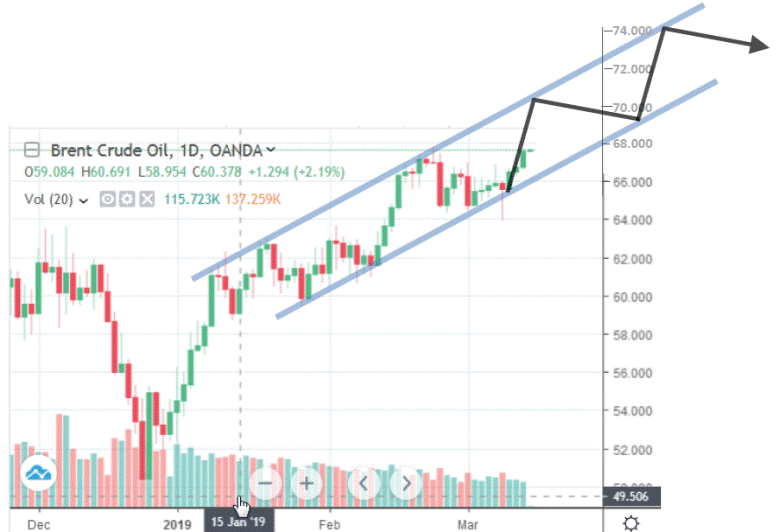
It could go more this time, because un-noticed by the flag-wavers, shale is spluttering. The number to watch is initial production (IP) by month as a function of trailing average price. IP is not reported directly by EIA in their monthly Drilling Productivity Report, but you can work it out from the numbers they do report. Theoretically IP minus Legacy loss ought to equal the monthly change in total production, long-term it does, see chart:
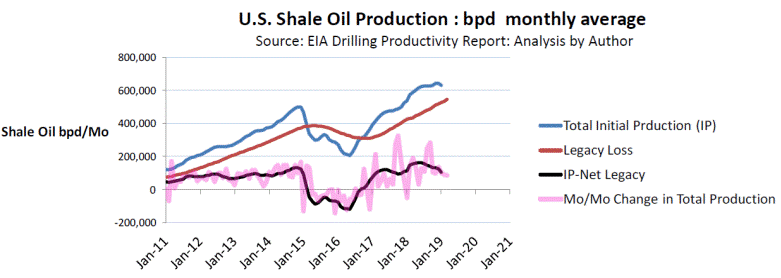
Short term the change in total production (how much was reported this month minus how much was reported, last month – even roustabouts can do the math on that one), bounces around.
If I was an economist I would say that proves the existence of Black Swans and means that the Federal Reserve should drop interest rates, another plausible explanation could be that as production went up, the logistics for getting the oil to market got stretched.
Notice that legacy-loss is climbing in a pretty straight line; total production growth has stalled; whenever; (if-ever); those two lines come together, that will be “Peak-Shale”. By the way I smoothed legacy-loss line because in Eagle Ford for a few months the reported numbers went haywire, I’m assuming that was a reporting error, so I treated it as an outlier (i.e. I ignored that data).
Currently 77% of IP is used to replace legacy loss; which is the root of the problem with shale oil. IP depends on the oil price, when that’s high operators drill and complete, when it’s low they polish their cowboy-boots, which is about the only other thing to do in Permian.
Shale operators say they can make money at $28 WTI (about $38 Brent). Just one small point, whenever WTI dips below $50 ($60 Brent), they start to pull back, which suggests that these days they don’t make money at that price.
Yes of course, history is an unreliable guide to the future, but if you couldn’t do something in the past (i.e. make money at $50 WTI), it’s unreasonable to tell your investors that you can. Here are some models of the past showing that U.S. Shale oil Initial Production, is driven ONLY by the price four and six months in the past:
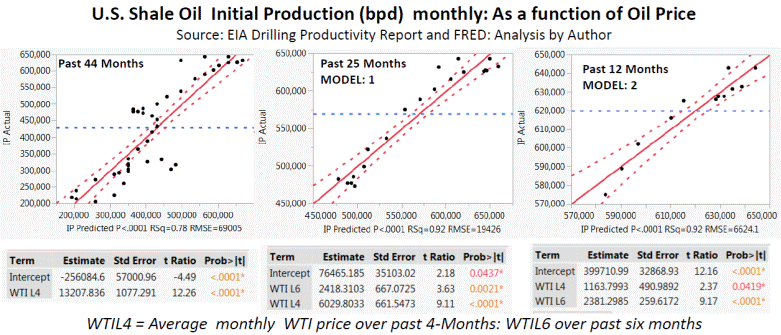
The model for the past 44-months has only one variable, so there cannot be any question about auto-correlation skewing the answer.
Above 400,000 the direction changed, I thought “I’m not interested in what happened more than two years ago, I’m interested in what’s happening now,” so I just ran the numbers for the past 25 months.
In the 25-month model both the price explanatory variables are positive (i.e. no chance of auto correlation), the model says that roughly 30% of changes of IP can be explained by changes in WTI-L6 and 70% can be explained by changes in WTI-L4.
A few months ago, I also noticed that over the past 12-months, the slope of the line of IP as a function of price has been dropping, so I modeled for just 12-Months (Model-2). I don’t like to make projections (which is obviously where I’m going), from such a short history, but that’s the problem projecting shale output, there’s not much history.
So IP is predictable from WTI. To arrive at a model of the theoretical change in Total Production, you need to take away legacy-loss this month. Legacy loss averages about 6.4% of last month’s Total Production. Why last month? Well legacy loss this month also correlates with Total Production this month, but I can’t use that because that’s the number I’m trying to find.
![]()
Obviously for the first line of the model I use actual for TP last month, got to start somewhere. Seeing as some commentators on my previous post were interested in the detail, line by line, I’m showing how the arithmetic to get to a model of total monthly production was worked out; enjoy!
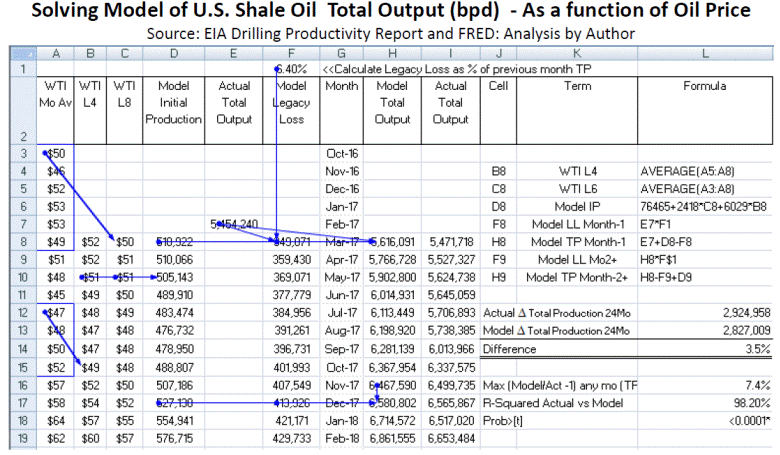
That model was solved for the future, for different scenarios of WTI going forwards from today, i.e. the $90 scenario, was for “What-if WTI goes to $90 next month and stays there?” This is how that turned out:
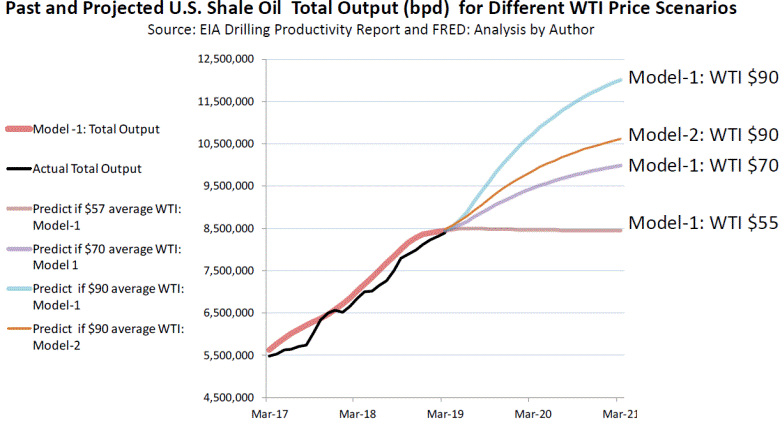
Comments:
- Although there is a very good correlation between the model of TP and actual, the model consistently over-estimates compared to actual. A plausible explanation for that is because the model is derived from a model of IP-net-legacy, which represents a theoretical capacity, in reality there are logistical issues (lack of pipeline capacity in Permian, for example), which means operators can’t ship everything they could have.
- First rule of crystal-ball gazing is that you never project outside the range of the data. The models were based on the past when WTI ranged from $45 to $74, so it’s reasonable to use the model to project for the scenario of $55 and $70.
- I’m saying now that the price that will give “Peak-Shale” (i.e. output growth goes to zero), is about $55 WTI. That’s a little higher than the number I figured three-month-ago by eye-balling.
- My opinion, the most likely scenario going forwards is that WTI will settle around $70, which (according to the model), would give an increase in total production of 1.5 million bpd over two years (2019 and 2020), i.e. 750,000 bpd per year; compared to 1.5 million bpd per year in 2018.
- Notice the curve flattens-off, that’s Peak Shale looming in 2021, due to the inexorable erosion of production by legacy-loss.
- $90 WTI didn’t happen for a long time, certainly not anytime in the data that formed the basis of the model; so projecting that scenario into the future, is entirely speculative.
- Solving Model-1 (25 months), gives a big number, but I don’t believe that.
- Model-2 is a more plausible projection, because that’s the most recent past, also the number of data-points, more than $70, is a higher percentage.
- That says two-million bpd over the next two years, one-million a year. The point to be made; is that OPEC & Co can handle that, if they are inclined. $70 WTI ($80 Brent), is about the price they have been saying was “fair” for more than ten years.
- What they mean by “fair” is regardless of what the venerable President of the United States of America, might tweet, the world can afford to pay $80 Brent, and that price is sufficient for conventional E&P operators to stop polishing their cowboy boots and go back to work. Another word for that, according to International Valuation Standards, is Other Than Market Value.
- Solving that model for “What-if-Shale output went up by 1.5 million bpd per year,” says WTI will need to be $150.
- Could that be a scenario worthy of a line in the annual corporate risk-analysis?
- If that’s on the cards, better pull on your safety boots, and go sign up some five-year charters with Transocean, before they double their day-rates.
Of course correlation does not prove causation, but like the correlation between “holding hand-rails” and “not falling down stairs”, correlation that explains the past, is not a bad starting point.
$100 and $150 ought to be scenarios for Brent in 2020 in any coherent risk analysis, another word for that is a global recession, whilst conventional E&P catches up, because the evidence of the recent past is that U.S. Shale oil won’t.
By Andrew Butter
Twenty years doing market analysis and valuations for investors in the Middle East, USA, and Europe. Ex-Toxic-Asset assembly-line worker; lives in Dubai.
© 2019 Copyright Andrew Butter- All Rights Reserved
Disclaimer: The above is a matter of opinion provided for general information purposes only and is not intended as investment advice. Information and analysis above are derived from sources and utilising methods believed to be reliable, but we cannot accept responsibility for any losses you may incur as a result of this analysis. Individuals should consult with their personal financial advisors.
Andrew Butter Archive |
© 2005-2022 http://www.MarketOracle.co.uk - The Market Oracle is a FREE Daily Financial Markets Analysis & Forecasting online publication.



